Teaching Hamilton
 I’m late to the Hamilton party. However, I’ve decided to include Lin-Manuel Miranda’s hit musical in my honors composition class for the fall semester. I’m drawn to Hamilton and the possibilities the musical presents for my particular classroom for several reasons. First, Hamilton fits thematically with the other texts included in my class. This particular composition course focuses on an already developed theme of memory and revision, and by extension history. The course theme is explored through a combination of texts selected in consultation with other faculty members teaching their own sections of the same course. Second, Hamilton, with its focus on writing, representation, and rhetoric fits well within a composition class. Additionally, Hamilton is an opportunity to consider how sources are used and reimagined, another significant component of the composition classroom. Third, in consideration of the costs for my class, I’m drawn to the accessibility of Hamilton through free steaming services like Spotify or YouTube. Additionally, students can purchase a digital or physical copy of Hamilton. Fourth, Hamilton is different and I appreciate the coincidence that its timely rise occurs in an election year. Fifth, and last, I like the idea of not having to read or re-read Hamilton. I will incorporate the crowdsourced annotated text of Hamilton in my class, along with other readings, but in the last half of the semester the focus is on writing and related assignments.
I’m late to the Hamilton party. However, I’ve decided to include Lin-Manuel Miranda’s hit musical in my honors composition class for the fall semester. I’m drawn to Hamilton and the possibilities the musical presents for my particular classroom for several reasons. First, Hamilton fits thematically with the other texts included in my class. This particular composition course focuses on an already developed theme of memory and revision, and by extension history. The course theme is explored through a combination of texts selected in consultation with other faculty members teaching their own sections of the same course. Second, Hamilton, with its focus on writing, representation, and rhetoric fits well within a composition class. Additionally, Hamilton is an opportunity to consider how sources are used and reimagined, another significant component of the composition classroom. Third, in consideration of the costs for my class, I’m drawn to the accessibility of Hamilton through free steaming services like Spotify or YouTube. Additionally, students can purchase a digital or physical copy of Hamilton. Fourth, Hamilton is different and I appreciate the coincidence that its timely rise occurs in an election year. Fifth, and last, I like the idea of not having to read or re-read Hamilton. I will incorporate the crowdsourced annotated text of Hamilton in my class, along with other readings, but in the last half of the semester the focus is on writing and related assignments.
Hamilton in the Composition Classroom
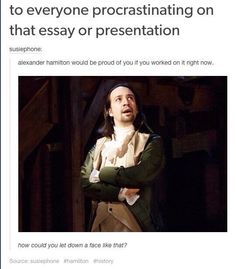 While I’ll be teaching literature in the fall, it will be within the parameters of a first-year writing class. In the context of a writing class, I’m also drawn to Hamilton because of its use and remixing of texts and archival sources. The innovative way Hamilton imagines, reimagines, and riffs on history today could be very inspirational to students. I also appreciate how it takes a topic, a subject, and an idea from the past and makes it very much about today. I am still formulating what I will do in my own class in regards to assignments, but I do envision Hamilton as being the big thing that we do for the semester. To that end, I’d like for my students to do some form of a public facing project, ideally they would work with material from the Heinz History Center. A research assignment that allows students to work with archival material in their own backyard and in a context of their own city would be an amazing opportunity. Empowering students to work with archival sources would not only help develop their writing and researching skills. An opportunity to work locally and in the archive would help students harness immediacy of the past that Hamilton provides through how it reimagines the use of the archive.
While I’ll be teaching literature in the fall, it will be within the parameters of a first-year writing class. In the context of a writing class, I’m also drawn to Hamilton because of its use and remixing of texts and archival sources. The innovative way Hamilton imagines, reimagines, and riffs on history today could be very inspirational to students. I also appreciate how it takes a topic, a subject, and an idea from the past and makes it very much about today. I am still formulating what I will do in my own class in regards to assignments, but I do envision Hamilton as being the big thing that we do for the semester. To that end, I’d like for my students to do some form of a public facing project, ideally they would work with material from the Heinz History Center. A research assignment that allows students to work with archival material in their own backyard and in a context of their own city would be an amazing opportunity. Empowering students to work with archival sources would not only help develop their writing and researching skills. An opportunity to work locally and in the archive would help students harness immediacy of the past that Hamilton provides through how it reimagines the use of the archive.
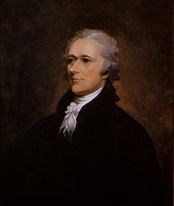 In describing my reasons for using Hamilton, I intentionally broke every single rule of describing our relationship to a student-centered pedagogy. I broke these rules because I wanted to illustrate the potential difficulties of developing a class or unit centered on Hamilton. When academics write materials for job applications, we’re encouraged to use the application letter and teaching statement as a place to focus on students and, at least semantically, deemphasize our role as the sage on the stage and the center of the classroom. There are many reasons that teachers, ranging from high school to colleges and universities, are drawn to Hamilton. There are many ways that teachers see the pedagogical affordances of Hamilton in the classroom. These reasons are individual and diverse as the instructors thinking about using Hamilton. The diversity of perspectives and approaches to Hamilton makes it difficult to construct a community resource for teachers using the musical.
In describing my reasons for using Hamilton, I intentionally broke every single rule of describing our relationship to a student-centered pedagogy. I broke these rules because I wanted to illustrate the potential difficulties of developing a class or unit centered on Hamilton. When academics write materials for job applications, we’re encouraged to use the application letter and teaching statement as a place to focus on students and, at least semantically, deemphasize our role as the sage on the stage and the center of the classroom. There are many reasons that teachers, ranging from high school to colleges and universities, are drawn to Hamilton. There are many ways that teachers see the pedagogical affordances of Hamilton in the classroom. These reasons are individual and diverse as the instructors thinking about using Hamilton. The diversity of perspectives and approaches to Hamilton makes it difficult to construct a community resource for teachers using the musical.
Why Hamilton?
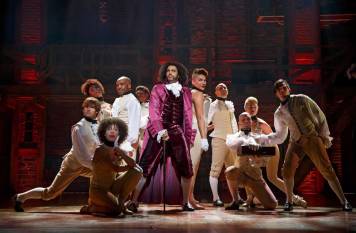
Hamilton is many things to many people, but for me, at least, it represents language, writing, and ideas. My Hamilton decision is also colored by the need to create a class that is focused on literature and writing instruction, an often difficult task. Hamilton places a self-aware emphasis on writing, language, and ideas and that emphasis makes the musical attractive in a writing class. Hamilton is also different and I want to students to the see the liveliness and potential of and for writing found in something vibrant and dynamic. I want students to see inspiration in an innovative text, one that is alive as a text and as a phenomenon. The best composition textbooks can’t achieve that sense of immediacy and vibrancy. Hamilton is also interesting because it provides an occasion for writing, too. Take for example Miranda’s recent op-ed in The New York Times. Miranda uses this piece of writing to address the debt crisis in Puerto Rico and it provides a fascinating way for students to see the intersection of public writing, sources, and a writer’s authority. There is much value when students can see examples of public writing, especially as it relates to topics that they may feel a connection with in their daily lives. While students may not write a musical about their research, but they’ll still have the opportunity of experience something similar to Miranda’s effort of researching and remixing and making something new and making it his own. It is important for students to see how texts exist in an every changing conversation and Hamilton provides that opportunity.
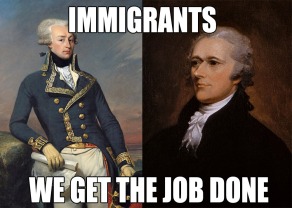
Hamilton is a new text and its emergence coincides with charged political debates about immigration and race. Additionally, as radical and out of the box as Hamilton is, its newness is subsiding enough that people are beginning to challenge exactly how much it pushes back against the unconventionality that made it dynamic and appealing to audiences. Critics and scholars are challenging how out of the box is the remixing of race and history in Hamilton. Plus there is increasing attention to the conventional up-by-the-bootstraps ideology presented in Hamilton. The history celebrated by Hamilton isn’t immune from a critical eye, either. I don’t point out these criticisms to undermine Hamilton, but I do point them out as ways to illustrate ongoing conversations about the musical. Public discussions that critically engage Hamilton provide students easier entrance to the idea of entering a conversation as opposed to jumping into academic writing. Lyra Monteiro’s recent work on race and Hamilton fits within the context of the shift between academic argument and a publicly engaged version of the argument. Students can read Monteiro’s recent academic article, hear the argument presented in a podcast interview with Ed Morales, and read the argument in a recent interview with Rebecca Onion. The different iterations of Monteiro’s work, and others, illustrates to students the different ways we have of presenting arguments.
Hamilton Online
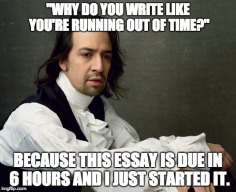 The conversations surrounding Hamilton are often fueled by the online world. Hamilton, for a staged musical, is viral text. Even with its focus in the past, Hamilton is reflective of now and how ideas circulate. Favorable reviews of Hamilton helped the musical, but word of mouth, especially online, drove a lot of attention to it. We can see origins of the musical online going back to Miranda’s 2009 performance at the White House. Hamilton isn’t only a viral text: it is emerging as part of a viral intertext through its annotated lyrics on Genius and through memes and parodies remixing the opening number. Much of the attention heaped on Hamilton is driven by a sophisticated social media campaign I want my students to see how texts revolve and evolve in an online world. I want them to see wow audiences change and how new audiences emerge. Hamilton can do these things and the #Ham4Ham campaign is an excellent illustration of the mixing and remixing that Hamilton provides to audiences—both in person and online.
The conversations surrounding Hamilton are often fueled by the online world. Hamilton, for a staged musical, is viral text. Even with its focus in the past, Hamilton is reflective of now and how ideas circulate. Favorable reviews of Hamilton helped the musical, but word of mouth, especially online, drove a lot of attention to it. We can see origins of the musical online going back to Miranda’s 2009 performance at the White House. Hamilton isn’t only a viral text: it is emerging as part of a viral intertext through its annotated lyrics on Genius and through memes and parodies remixing the opening number. Much of the attention heaped on Hamilton is driven by a sophisticated social media campaign I want my students to see how texts revolve and evolve in an online world. I want them to see wow audiences change and how new audiences emerge. Hamilton can do these things and the #Ham4Ham campaign is an excellent illustration of the mixing and remixing that Hamilton provides to audiences—both in person and online.
.
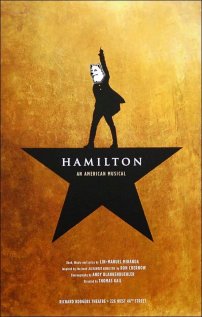
I also appreciate the affordances of Hamilton in the classroom because of the nature of the material available online. The newness of Hamilton makes sorting through online resources and articles difficult. I don’t offer this up as an anti-plagiarism deterrent, but I offer it up as acknowledging that students will spend much of their early research on the internet—or perhaps entirely. I like how the unique circumstances surrounding Hamilton provide an opportunity in the classroom setting for students to become better consumers of online content. It is difficult to push back against the draw of internet sources, but engaging with Hamilton in an online context provides opportunities for students to become critical consumers of online materials.
Your Hamilton and My Hamilton
While the newness and excitement of Hamilton provides exciting opportunities for teachers, that same newness makes planning a portion of a semester around Hamilton difficult. Good pedagogy often relies on preexisting ideas, tools, and resources for teaching. It makes sense to learn from others, especially when trying something new in the classroom. It was in this spirit that, shortly after deciding I’d incorporate Hamilton in my fall honors composition class, I hit the internet and Twitter looking for ideas and resources. I was honestly surprised by the lack of resources focused on the nuts and bolts of teaching Hamilton given the widespread excitement about the pedagogical possibilities of using the musical in the classroom. There are several articles about the exciting potential of Hamilton in the classroom, along with pieces in various media highlighting what one could do in general with Hamilton in the classroom, but a unified body of information on approaches remains largely absent. Collections of sources are emerging and growing. Suggestions on teaching remain elusive and there is a tendency to recommend borrowing from approaches to teaching 1776.
Their Hamilton
In many cases the emphasis on Hamilton resources is focused on Alexander Hamilton. Helpful, depending on what an instructor hopes to do in the classroom, Alexander Hamilton and Hamilton aren’t the same things. For educators excited about using Hamilton in the classroom, the musical likely represents many things to many teachers. The pedagogical applications of Hamilton appeal to instructors regardless of level or academic field. Goals and purposes are different. And, perhaps most importantly, the student audiences are varied, not just in level, but in the context of the classes themselves. Hamilton has potentially unlimited ways of being incorporated in writing, history, literature, or arts classrooms. Hamilton, depending on the goals of an instructor, could be taught in ways that dovetail with numerous pedagogical goals that highlight not only history and art, but race, class, gender, and many other topics.
Your reasons and my reasons for wanting to use Hamilton in the classroom are likely different. The goals you have to accomplish and the goals I have to accomplish are likely different, too. The reasons why I want to use Hamilton in the classroom represent my ideas. My ideas for Hamilton respond to the goals that I am required to meet for my composition class. My ideas for using Hamilton reflect my own pedagogical attitudes. My approach to Hamilton reflects my own training as a literary scholar and my bend towards literary history. These are my goals and while they might resonate with other teachers, they are likely not the same.
Miranda, with his experience as a teacher, made it well-known his desire for Hamilton to be used in the classroom. The emphasis on this mode of engagement has infused the popular social media campaigns of the musical. It is this spirit of public engagement, especially in the classroom, that has brought forward The Rockefeller Foundation supported initiative to bring Hamilton to the students of the public schools of New York City through a partnership between the NYC Department of Education and Gilder Lehrman. Significant stakeholders and, most importantly, funding have come together to create a set of resources for the classroom. I applaud these initiatives. Plus, someone else is going to do the hard work of creating a set of resources. However, as of right now, many of the resources of Gilder

Lehrman are only open to participating schools in the program. Many other free resources exist on the Gilder Lehrman website, but follow a thread far enough and it ultimately ends in a paywall. While one can pay for an individual subscription to the Gilder Lehrman website, such a subscription potentially represents a significant expense for many cash strapped college students.
#HamiltonSyllabus versus #TeachingHamilton
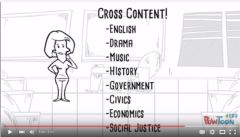
Our fields, goals, or limitations of the classroom might be different, but, if you’re reading this, we share the same excitement of the possibilities of using Hamilton in the classroom. It is that shared excitement and enthusiasm that should be the first tenet of creating a repository of resources for teaching Hamilton. There is a reason for this Hamilton conundrum and it goes beyond the newness of the musical. The versatility of Hamilton, the very reason it appeals to educators, is exactly what makes it a difficult candidate for corralling into a #HamiltonSyllabus. In terms of logistics, a #HamiltonSyllabus can’t account for even a fraction of everything, but it could highlight resources that make for an excellent addition to students’ classroom experience of Hamilton. Yes, Hamilton is still new, but chalking up a lack of Hamilton resources to newness is too simplistic. Each instructor envisions unique reasons for using Hamilton in their classroom, and each instructor likely has their own reasons for meeting pedagogical goals in a certain way. Individual needs and the complexity of each classroom environment seemingly rejects a neatly organized and packaged #HamiltonSyllabus.
While a #HamiltonSyllabus can’t be all things to all instructors. However, in recognition of the musical’s wide appeal, the #HamiltonSyllabus should be made up exclusively of, or at the very least lean heavily towards, open access resources. Freely riffing and borrowing musical idioms, language, and history is at the heart of Hamilton and that spirit of riffing and borrowing should be at the heart of a call for open access resources. The spirit of open access and public engagement is also embodied in the offstage experience of Hamilton, whether through the freely available music online, or the various social media campaigns, or the free public performances for those that can’t get tickets.
Approaches and topics are endless with regards to Hamilton. Race, gender, history, musical history, Broadway history, rap and hip-hop, class, and immigration can all be taken up in considerations of Hamilton. Potential topics are as endless as the potential classroom approaches. Each teacher, for their own reasons, could list a world or reasons for teaching Hamilton and how to approach it. For these reasons I’m hesitant to make a call for a #HamiltonSyllabus. Instead, I propose call for a community of instructors using Hamilton in the classroom: #TeachingHamilton. At some point, perhaps the community built around #TeachingHamilton could collaborate on resources for a #HamiltonSyllabus. For now, #TeachingHamilton is a good start.
What would you do for a World Literature classroom? I would love to hear thoughts.
LikeLike
Hi Sarah,
Thanks for posting such an awesome question. We’ve been talking behind the scenes about your question and trying to gather up some potential ideas.
Shelli Homer, one of our contributors, thinks Hamilton could be fit into a context of colonization or imperialism context within the world lit classroom. Building off of Shelli’s thoughts, I think the New York Times op-ed that Miranda wrote about Puerto Rico fits with that context of addressing the legacy of imperialism and colonization. The op ed creates an interesting moment of intertextuality connecting the past, present, and political advocacy.
When we first ran our Hamilton post we had a response from Marilisa Jimenez, via Twitter. You can find her tweet here: https://twitter.com/MarilisaJimenez/status/718094838416207872 She used a song from Hamilton as a way into a Latino literature class.
Hamilton uses a complex sense of what it means to be an immigrant. I think it is one of the clearest moments in the musical that illustrates that the musical is very much about today and a product of today. It is an issue that I think loops back in a very profound way to Miranda’s op-ed. And I think it would be a great illustration for students. It is one of the threads that I hope to pick up with my students in the fall.
I just ordered a copy of Hamilton: The Revolution. Miranda shares a lot about the evolution of the musical in the book. It might be worth taking a look at, too. I’ll have a better sense of it when I delve deeper into the book. One of my early impressions of the book is that it serves as separate text, partly with a mission to respond to some criticisms of the musical.
We really liked your question and think it is an important one. We hope to have some more ideas in the future! Thanks for reading!
LikeLike